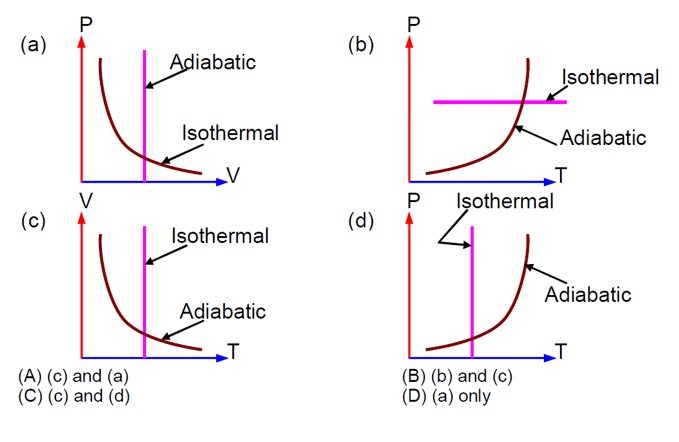Physics Thermodynamics
Get insights from 155 questions on Physics Thermodynamics, answered by students, alumni, and experts. You may also ask and answer any question you like about Physics Thermodynamics
Follow Ask QuestionQuestions
Discussions
Active Users
Followers
New answer posted
a month agoContributor-Level 10
As increased by 3 times
So
- (c) Fundamental harmonic frequency open pipe
(say)
Fundamental harmonic frequency of closed pipe
(say)
New answer posted
a month agoContributor-Level 10
PV? = C ⇒ V? (dP/dV) + P (γV^ (γ-1) = 0 ⇒ dP/dV = -γ (P/V) ⇒ dP/P = -γ (dV/V)
New answer posted
a month agoContributor-Level 10
Pressure decreases with an increase in volume in both isothermal and adiabatic processes. In an adiabatic process, as volume decreases, pressure increases with the increase in temperature.
New answer posted
a month agoContributor-Level 10
In an LCR series AC circuit, the phase difference φ between current and voltage is: φ = tan? ¹ (X? - X? ) / R)
If each vibrational mode contributes two degrees of freedom and the total degrees of freedom f = 3 + 3 + 4 = 10, then:
β = 1 + 2/f = 1 + 2/10 = 1.2
New answer posted
a month agoContributor-Level 9
For adiabatic process CD,
W = (P? V? - P? V? ) / (γ - 1) = (100 * 4 - 200 * 3) / (1.4 - 1) = -500J
New answer posted
a month agoContributor-Level 10
U = U? + U? = (n? /N_A) (F? R/2)T? + (n? /N_A) (F? R/2)T?
For the mixture: U = (n? +n? )/N_A * (FR/2)T
F = (n? F? + n? F? ) / (n? + n? )
Equating the expressions for U and solving for T gives:
T = (n? F? T? + n? F? T? ) / (n? F? + n? F? )
New answer posted
a month agoContributor-Level 10
η = 1 - T_C / T_H
η = 1 - 400/800 = 1 - ½ = ½
η = W/Q_H ⇒ ½ = W/Q_H ⇒ Q_H = 2W = 2 * 1200 = 2400 J
New answer posted
a month agoContributor-Level 10
f = f_Translational + f_Rotational + f_Vibrational
f = 3 + 3 + 48 = 54 (Since each vibrational mode has two degrees of freedom)
γ = 1 + 2/f = 1 + 2/54 = 1 + 1/27 = 28/27 ≈ 1.03
New answer posted
a month agoContributor-Level 10
1/4 m (210)² = m (0.03) x (4.2) x 1000 x ΔT ; Q = mSΔt
ΔT = (210) (210)/ (4) (4.2) (0.03) (1000) = 87.5°C
Taking an Exam? Selecting a College?
Get authentic answers from experts, students and alumni that you won't find anywhere else
Sign Up on ShikshaOn Shiksha, get access to
- 65k Colleges
- 1.2k Exams
- 688k Reviews
- 1800k Answers

